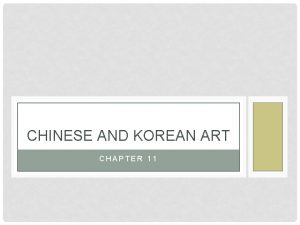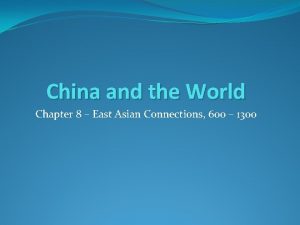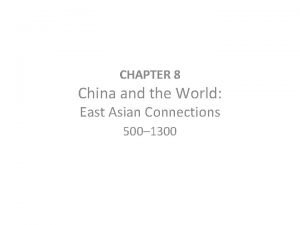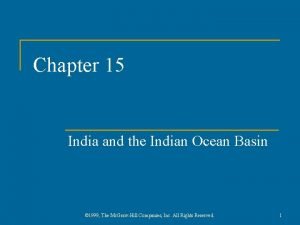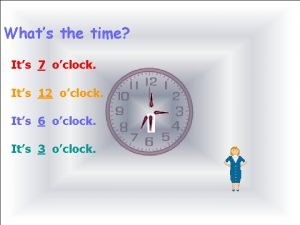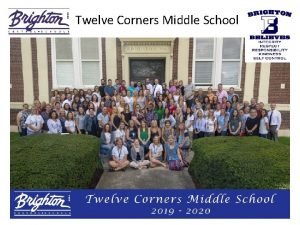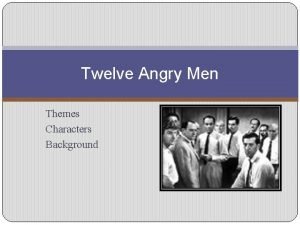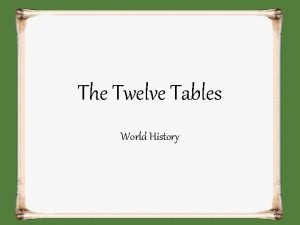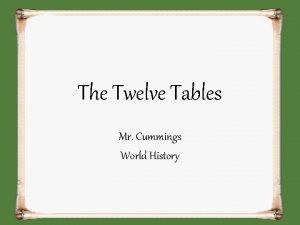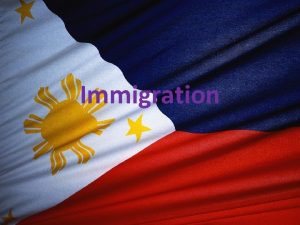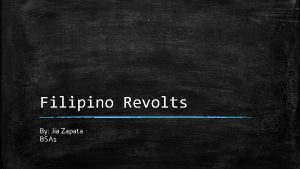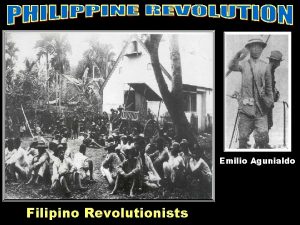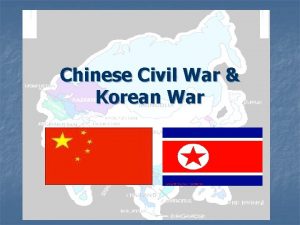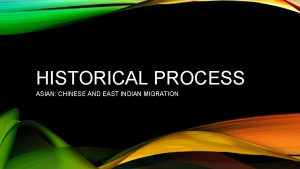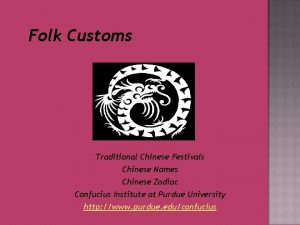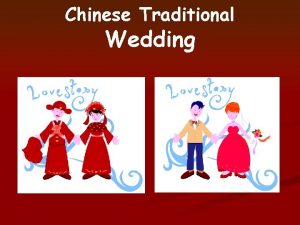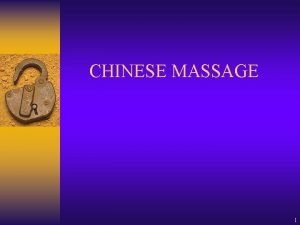Chapter Twelve Chinese Korean Filipino and Asian Indian



















- Slides: 19

Chapter Twelve: Chinese, Korean, Filipino, and Asian Indian Americans • Generally, traditional Asian values emphasize appropriate behavior, strict control of aggressive or assertive impulses, and a self-conscious concern for conduct in the presence of others • Family unity/cohesion • Elders in the family command respect and obedience

Chinese Americans • • Immigration to U. S. prompted by: 1848 California gold rush Transcontinental railroad 1868 Burlingame treaty “Credit Ticket System” Brought many men, few women After railroad completed, hostility increased

• The Chinese Exclusion Act (1882) marked the first time the government enacted a human embargo on a particular race of laborers • Expelled from various trades and occupations as well as from many residential areas, Chinese immigrants had no choice but to congregate in Chinatowns • Many returned to China

• The development of Chinatowns • Involuntary choice in response to societal prejudice & discrimination • Protection against racist hostility • Voluntary segregation as group consciousness emerges • Gradual assimilation, a process markedly slowed by voluntary segregation and social isolation • Congress ended the ban on immigration from China in 1943.

• Many more Chinese men than women • The War Brides Act in 1946 and the GI Fiancées Act in 1947 brought Chinese women to the U. S. • Establish larger family community

Chinese Americans’ Early and Later Assimilation • Early immigrants mainly spoke Cantonese, came on boats, were mostly male, and worked labor jobs. They were less secondary assimilated, but their children (the few they had) were culturally assimilated • Later immigrants mainly spoke Mandarin, came on airplanes, came in families, and worked jobs requiring education or a high level of skills. They are more secondary assimilated than earlier generations, but less culturally assimilated

Korean Americans • Thousands came to Hawaii to work in sugar cane fields. This halted once Japan occupied the Korean peninsula • The Gentlemen’s Agreement applied to Korea, and Koreans were classified as WWII enemy aliens until the end of WWII • Korean military conflict between 1950– 1953 with residual military force still in place today

• Not until the end of the Korean War and the passage of the Refugee Relief Act in 1953 did Koreans emigrate in substantial numbers • Many came already baptized by Christian missionaries (Methodist) • Churches acted as religious, cultural, and language centers • Churches also helped to resist Anglo American hostility

• Men came as sojourners • The sex ratio was imbalanced early on • Picture brides program helped balance # of women to men • 1950 -1953 - 6000 war orphans and 6000 students migrated

Korean American Assimilation Patterns • By the late 1990 s, more than 70% of Korean Americans were first-generation immigrants • Newer immigrants were very educated, came with families, and trained as professional or technical workers. Many were also Protestants • Nationwide, the 12% self-employment rate of Korean Americans is the highest of all ethnic or racial groups, including whites

• Many favor cultural assimilation by addition • Rapid movement toward marital assimilation • Many became U. S. citizens

Filipino Americans • Philippines ruled by Spain for 300 years • Mixture of Christianity and Islam • U. S. joined Filipinos in conquering Spain. Philippines fell under U. S. control • In 1898 the Philippines became a U. S. possession and the inhabitants were considered U. S. nationals

• Of every 100 Filipinos coming to California between 1920 -1929, 93 were male • In 1934, the Philippines was reclassified from a territory to a commonwealth by the Tydings-Mc. Duffie bill. The Filipinos soon adopted a constitution and elected a president • In 1946, after WWII ended, the Philippines islands became an independent country, which reclassified all the Filipinos living in the U. S. as aliens and placed them under the Immigration Act of 1924

• Since the Immigration Act of 1965, Filipino immigration has been quite high • About half of all Filipino Americans speak only English • The largest concentration of Filipinos outside the Philippines is in Hawaii • Locals felt strongly threatened by Filipino men dating white women, which contributed to racism, negative stereotypes, discrimination, and other problems

Filipino American Assimilation Patterns • New immigrants tend to be a very high SES group, speak English well, and work in higher occupation jobs—many in the health-care industry • They have the highest rates of naturalization among Asians— 68% • High interracial marriages • High median income level for a U. S. ethnic group

Asian Indian Americans • Hindi is the language of the modern Republic of India (Bharat). An established ranking caste system has made distinctions between races and economic groups. Hindu is the most common religion, followed by Islam • European cultures and countries influenced India via trade and political intervention • Coolie laborers and a few students came to Hawaii and the U. S. early in the 19 th century

• Early Asian Indian immigrants were mostly from Punjabi and were Sikhs, not Hindus • Discrimination b/c of cultural and religious differences • Caucasian features but skin color ranging from light to dark • In 1923 the U. S. Supreme Court reversed previous lower-court decisions and ruled that Asian Indians were nonwhites and thus ineligible for citizenship under the terms of the 1790 Naturalization Act

• In 1946 the Luce-Celler Bill removed Asian Indians from the “barred zone” • The Immigration Act of 1965 and the conditions in India contributed to the increase in Asian Indian migration • Very few immigrants came prior to 1960, and 800, 000 came since then • Between 2001 and 2003 180, 000 newcomers arrived from India

Asian Indian American Assimilation Patterns • Half of second- and third-generation immigrants have a college education and high income levels • High English proficiency and high cultural and secondary assimilation, but relatively low interracial marriages
 Tongue twisters funny
Tongue twisters funny Chinese and korean art
Chinese and korean art Anglo chinese primary
Anglo chinese primary Chapter 8 china and the world east asian connections
Chapter 8 china and the world east asian connections Chapter 8 china and the world east asian connections
Chapter 8 china and the world east asian connections Lesson twelve saving and investing
Lesson twelve saving and investing What has 8 vertices and 6 faces
What has 8 vertices and 6 faces Chapter 15 india and the indian ocean basin
Chapter 15 india and the indian ocean basin Chapter 15 india and the indian ocean basin
Chapter 15 india and the indian ocean basin How are elephants a keystone species
How are elephants a keystone species Black and asian counselling network
Black and asian counselling network 7 oclock
7 oclock What are the terrible twelve water pollution
What are the terrible twelve water pollution Tcms morning show
Tcms morning show 12 angry men theme
12 angry men theme Twelve tables summary
Twelve tables summary Twelve tables
Twelve tables Twelve principles of green chemistry
Twelve principles of green chemistry One two three four five six numbers
One two three four five six numbers Roman twelve tables laws
Roman twelve tables laws

